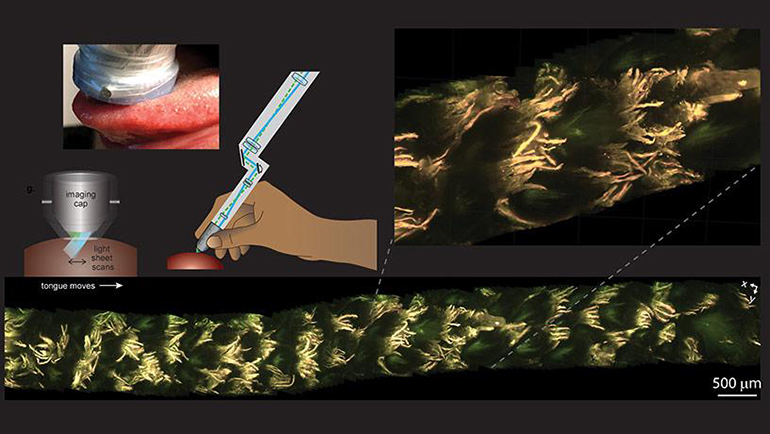A team at Columbia University created a 3D microscope that can be used to image living tissues. The technology can help clinicians identify features in tissues without the need for histology or biopsies, and could be invaluable during surgical procedures. One application involves a surgeon using the scope to identify the boundaries of a tumor during a surgical procedure, without having to take tissue samples for rapid histological analysis. The technology also lets clinicians and researchers to roam over a tissue with the scope and then convert these data into a 3D rendering of a tissue structure, all without damaging the imaged structures.
There is a long tradition of removing tissues from the body in order to analyze them. Histological techniques have evolved over a very long time, and have been instrumental to modern medicine. But what if we could analyze live tissues in situ, in near real time, and even create 3D models of imaged tissue structures? This approach has now been realized by a new technology which could blow many conventional histological practices out of the water.
“The way that biopsy samples are processed hasn’t changed in 100 years, they are cut out, fixed, embedded, sliced, stained with dyes, positioned on a glass slide, and viewed by a pathologist using a simple microscope. This is why it can take days to hear news back about your diagnosis after a biopsy,” said Elizabeth Hillman, a researcher involved in the study.
 MediSCAPE imaging of fresh human kidney compared to gold standard periodic acid-Schiff (PAS) histology of the same tissue. Center shows large area scanned using MediSCAPE. Panels point to specific features of the kidney that are either normal or represent disease. 488 nm excited autofluorescence is color-coded in a yellow-blue scale.
MediSCAPE imaging of fresh human kidney compared to gold standard periodic acid-Schiff (PAS) histology of the same tissue. Center shows large area scanned using MediSCAPE. Panels point to specific features of the kidney that are either normal or represent disease. 488 nm excited autofluorescence is color-coded in a yellow-blue scale.
The new microscope, which the researchers describe as “miniaturized high-speed light-sheet microscope for in-situ volumetric histological imaging,” can obtain detailed tissue images of living flesh. Part of the technology’s success lies in its ability to rapidly acquire images and its high sensitivity in detecting the small amount of fluorescence naturally present in tissues, meaning that fluorescent labeling molecules or other stains are not required.
“One of the first tissues we looked at was fresh mouse kidney, and we were stunned to see gorgeous structures that looked a lot like what you get with standard histology,” said Kripa Patel, another researcher involved in the study. “Most importantly, we didn’t add any dyes to the mouse – everything we saw was natural fluorescence in the tissue that is usually too weak to see. Our microscope is so efficient that we could see these weak signals well, even though we were also imaging whole 3D volumes at speeds fast enough to rove around in real time, scanning different areas of the tissue as if we were holding a flashlight.”
The researchers hope that the technology could be particularly useful for surgeons who wish to examine tissue composition in real time. “Such a technology could give a doctor real-time feedback about what type of tissue they are looking at without the long wait,” said Hillman. “This instant answer would let them make informed decisions about how best to cut out a tumor and ensure there is none left behind.”
See a 3D rendering from the microscope below.
Top image: MediSCAPE imaging of the living human tongue. Subject slowly licked the MediSCAPE imaging head while high-speed 3D images were acquired. Volumes were then stitched to form long 3D strip below. Contrast shows red and green autofluorescence with 488 nm excitation. Inset left shows MediSCAPE imaging geometry in which an oblique light sheet is used to illuminate the sample, and scans from side to side to rapidly capture 3D images. Inset right shows concept of hand-held MediSCAPE system for intrasurgical use.
Study in Nature Biomedical Engineering: High-speed light-sheet microscopy for the in-situ acquisition of volumetric histological images of living tissue
Via: Columbia University
